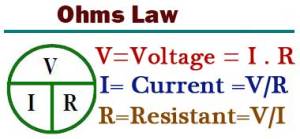What is Ohm's Law
I venture to say that most of us aren’t in music for the science. However, there are some places where knowing a little bit of science can help you manage the complexities of a full-range PA system or even something as simple as picking the right speaker cabinet for a guitar head. So, let’s learn about Ohm’s law and how it applies to choosing speakers for any power amp.
Google will tell you that Ohm’s law states that the current through a conductor between two points is directly proportional to the potential difference across the two points. It will also show you a graphic similar to the tattoo on the right. The tattoo and pie chart it is based on give you all sorts of helpful information on how to calculate watts, amps, voltage and more from whatever variables you already know about your circuit. Fortunately, you neither have to get this tattoo or know all these things to use Ohm’s law to pick the right speakers for your purpose.
Here’s what we do need to learn: an Ohm is a measure of impedance. You’ll see speakers and cabinets rated for 4 Ohms, 8 Ohms, and 16 Ohms. A power amp will provide maximum power to a speaker or cabinet that matches the impedance of the amplifier. So, if your guitar amp has an 8 Ohm output, you’ll want to connect an 8 Ohm speaker for maximum power. Also, using a different impedance speaker can cause problems. Too high can damage the output tubes or output transformer of your amp. Too low an impedance can overheat your amplifier.
Now, it is simple with one cabinet and one amp. Just match output impedance and speaker impedance and you are good to go. We actually start to use Ohm’s law when we want to hook multiple speakers or cabinets to a single power amp, which is a common occurrence in professional audio.
The tried-and-true explanation of Amperes, Voltage, and Impedance is found by comparison to an ordinary garden hose. The flow of water through the hose is the electrical current. It is measured in Amperes, or more commonly as Amps. The water pressure, the force of water through the hose, is Voltage. Placing your thumb over the end of the hose and blocking part of the flow is Impedance. So, from those examples, we can determine a few things about electricity. Increasing water pressure (Voltage) will increase the water flow (Amps), just a decreasing one will decrease the other. Increasing the Impedance, or how much your thumb is blocking the water, will decrease the water flow (Amps) and decreasing it will increase the water flow. This is where the actual Ohm’s law comes in, to summarize these relationships. Because they are all linked, when you know any two of these variables then you can mathematically work out the others.
That, however, is beyond our scope. Let’s talk about hooking up speakers. Most power amplifiers will give you a chart of how much power they produce at certain Ohms. Most guitar or bass amplifiers have an output labeled for one particular Ohm rating. Matching either of those with single speakers or cabinets labeled with the same Ohm rating is no problem. Hooking them to different rating is where we use Ohm’s law. There are two types of wiring to consider: parallel and series. Series wiring creates a loop where the current is shared by every speaker. Parallel is more like having a separate wires to each speaker so they are fed current individually.
Ohm’s law says this about parallel and series. In parallel, two 8 Ohm cabinets will create an impedance load of 4 Ohms on the power amplifier. This is most common in PA cabinets, that the pass-through jacks are wired to create a parallel circuit. In series, two 8 Ohm cabinets will create an impedance load of 16 Ohms. This is most common in situations where you are wiring your own speakers into a cabinet. So, series wiring increases impedance and parallel wiring decreases impedance. Here’s a chart covering some of the usual configurations:
To keep things simple, stick to similar Ohm ratings when using multiple cabinets and refer to your manufacturer notes to be sure whether you are dealing with parallel or series wiring. Again, for the most part, you’ll be seeing parallel circuits on nearly all pre-built cabinets out there, but it pays to be sure.
Want to learn more, or have a specific question? Submit it to the comments below or give us a call at (877) 347-6423 and we’ll have an answer for you.

 ">
">
 ">
">

